
Related
Guests
- Alegría De La Cruzdeputy county lawyer of Sonoma County.
- Juan Hernandezexecutive director of the La Luz Center in Sonoma, California.
Links
As catastrophic wildfires in California kill at least 42 people and leave thousands of homes and businesses in ruins, many of the area’s 20,000 undocumented immigrants have had no sanctuary from the flames, with some sleeping on beaches in order to avoid federal agents at shelters. This comes as far-right media outlets like Breitbart are falsely reporting that an undocumented immigrant was arrested in connection to the fires. Police said there is no indication the man had anything to do with the wildfires. We speak with Alegría De La Cruz, deputy county lawyer of Sonoma County, and Juan Hernandez, executive director of the La Luz Center in Sonoma, California.
Transcript
AMY GOODMAN: We’re broadcasting from the Community Media Center of Marin in San Rafael, California. Today is Community Media Day, which celebrates community media centers like this one around the country.
Here in California, catastrophic wildfires have killed at least 42 people and left thousands of homes and businesses in ruins. The fires are still burning across multiple counties near where we are broadcasting from. We’re in Marin, close to Sonoma County, which some say has taken the brunt of the destruction, and is home to about 20,000 undocumented immigrants, who have had little sanctuary from the fires. Last week, Immigration and Customs Enforcement, known as ICE, announced it would suspend non-criminal enforcement at shelters and evacuation centers here. But fear of deportation led some undocumented residents to set up camps on the beach or sleep in their cars, churches or other pop-up shelters in order to avoid federal agents. Some evacuees also face challenges returning to their homes because of police checkpoints.
Cal Fire is investigating the cause of the fires. Residents in Santa Rosa have sued the Pacific Gas and Electric Company, claiming the company’s failure to maintain its power lines sparked the blazes. The night the fires began, there were multiple reports of downed power lines and exploding electrical transformers.
This comes as far-right media outlets like Breitbart falsely reported an undocumented immigrant was arrested in connection with starting the fire. Police say they did arrest 29-year-old Jesus Fabian Gonzalez, a homeless man who had started a fire to keep warm. Deputies extinguished the small fire before any firefighters arrived. This was after the fires had begun. But on Tuesday, Sonoma County Sheriff Rob Giordano said there is, quote, “no indication that Gonzalez had anything to do with these fires and it appears highly unlikely.”
On Wednesday, ICE’s acting director, Thomas Homan, accused Sonoma County of being a, quote, “non-cooperative jurisdiction” that “has left their community vulnerable to dangerous individuals and preventable crimes,” unquote. The Sonoma County sheriff issued a scathing response, calling ICE’s statements inaccurate, inflammatory and damaging, and said, quote, ”ICE attacked the Sheriff’s Office in the midst of the largest natural disaster this county has ever experienced. … I hope to end this senseless public confrontation with these facts so that I may focus on the fire recovery,” he said.
Meanwhile, the fires have also contributed to an affordable housing crisis, leaving thousands homeless in neighborhoods of California where rental prices were already sky high before the blazes.
For more, we’re joined by two guests who work closely with the immigrant community here. Juan Hernandez III is executive director of the La Luz Center in Sonoma. And Alegría De La Cruz is chief deputy county counselor of Sonoma County, which is one of the main service providers for the large undocumented population.
We welcome you both to Democracy Now! Alegría De La Cruz, let’s begin with you. You are the chief deputy county counselor of Sonoma County.
ALEGRÍA DE LA CRUZ: That’s correct.
AMY GOODMAN: But also you have been appointed to communicate with the Spanish-speaking population here.
ALEGRÍA DE LA CRUZ: So, as chief deputy, I actually run an infrastructure group of about 11 lawyers who serve the county’s departments that do important things like parks, water, roads, etc. And I’ve also been responsible for leading the county’s efforts—coordinating the county’s efforts with regard to immigration service provision, as well as fundraising for legal service increase in capacity throughout the county.
AMY GOODMAN: Talk about what has just taken place, this attack by—it is reminiscent of Puerto Rico in the midst of their catastrophe, President Trump attacking the San Juan mayor, who you usually saw on television with water up to her chest, holding a bullhorn, trying to evacuate people safely. And he attacked her. Now you have the head of ICE attacking Sonoma County and the sheriff, who is trying to deal with the fires.
ALEGRÍA DE LA CRUZ: It really calls into question the public safety issues that are raised by local governments in the face of such increased efforts in terms of immigration enforcement. Two weeks ago, we, like others throughout the county, were training immigrant communities on how to protect themselves from immigration enforcement, and warning people to make sure that before they open the door to somebody in uniform, that they saw a signed judicial warrant. And only 10, 11 days later, we’re telling people, “Come on in for services, please. You’re safe here.” So the confusion and the conflict in people, and then their emotional state, especially in light of this extreme natural disaster and the hundreds and thousands of people that have been impacted by this, is very difficult for the community to kind of switch so quickly. And so, what we’re seeing is tens of thousands of people not coming in to receive services, to which they are entitled to, and continuing to seek service outside of the institutions that are designed to serve them.
AMY GOODMAN: Where did immigrants go, Juan Hernandez?
JUAN HERNANDEZ III: So, we had—
AMY GOODMAN: Undocumented.
JUAN HERNANDEZ III: Yes. We had a large report that a lot of them have gone—went to the coast. Doran Beach was one location that—
AMY GOODMAN: So they go to the ocean?
JUAN HERNANDEZ III: Yes. And a lot of it has to do with just—just functional, right? It was cleaner air. They wanted to get out to cleaner air. But I think that one of the key things that people need to understand is that communication was down completely. You could not use your cellphone. Internet was down. So communication, in general, was very hard to connect with people—English-speaking people, but, even worse, the Spanish-speaking people. So they had no way of communicating with anybody. All they saw was the fires coming down the hill.
AMY GOODMAN: And people run to the beach because they’re afraid to go to the evacuation centers? They’re heading to water?
JUAN HERNANDEZ III: Yes. So, what we saw was, again, the uncertainty of where to go. A lot of our families are disconnected from services. They’re disconnected from media. They’re disconnected. So the point was, is that they did the best they could to support their families.
AMY GOODMAN: So, Alegría De La Cruz, when people would knock on the door, they’re afraid to open it.
ALEGRÍA DE LA CRUZ: And this is in the face of a disaster, where people are required and needing to evacuate in order to save their lives. So, the county made a huge effort to ensure that information was provided in Spanish language, both written and as well as throughout the Spanish-language media, really trying to send the message to folks that, “OK, we’ve now shifted, and now ICE has promised not to enforce immigration laws at these places of service provision. Please come. Please come and receive benefits for you and your family that you are legally entitled to.” This is something that Sonoma County does on a regular basis as the largest service provider to the community. And so, being able to kind of shift and make sure that we’re continuing to do that, in our capacity as the county service providers, wasn’t necessarily far-fetched from what it is that we do every day for people.
AMY GOODMAN: So, respond to the head of ICE attacking your county, Sonoma County, where you are the chief deputy county counselor.
ALEGRÍA DE LA CRUZ: So, my office does represent the Sheriff’s Office. And I just want to kind of elevate his comments and to really highlight the fact that, in the face of such disaster and such emergency, to then be responding to these kinds of attacks, I believe Sheriff Giordano said it beautifully, that these statements are inflammatory and incorrect, and making these kinds of statements at this time takes away all of the energy that we have to be fighting fires—which are still burning—making sure that people have services and are continuing to be safe in this time. And it makes things very difficult to increase service provision to communities that are already vulnerable and in need of services, to continue to make efforts to make sure that people understand coming into shelters, coming into the local assistance center, is safe, that we are there to make sure that people are receiving benefits that they need in order to recover and that the recovery effort is equitable. These are not benefits that people are applying for illegally in any way. These are benefits to which families are legally entitled. And to be able to come into the center to receive this assistance is something that every Sonoma County resident who has been impacted by the fires has the ability and the right to do.
AMY GOODMAN: Can you comment on Breitbart News and others—but most importantly, the head of ICE, Homan—picking this up and accusing an undocumented immigrant of starting the fires? What is your understanding of what happened here?
ALEGRÍA DE LA CRUZ: The fires are still under investigation. The cause of the fires are still under investigation. It is premature at this stage. And it’s very clear from the investigation that was conducted with Mr. Gonzalez’s arrest that the fires could not have been caused by his small fire, which he was arrested for in the valley of Sonoma just a few days ago, many days after the fires had already started.
AMY GOODMAN: Juan Hernandez, talk about the housing crisis and now people having jobs. I mean, we’re here in San Rafael. It’s, oh, 20, 40 miles from Santa Rosa, where you are from, both of you. You live about five blocks apart. I mean, the images we have seen of parts of Santa Rosa right now, it’s a moonscape, this now-iconic picture of a mail carrier, a truck, going through a completely burned-out area. How many people—what, about 100,000 people have been evacuated?
ALEGRÍA DE LA CRUZ: That’s correct, over the—over the course—
AMY GOODMAN: Overall.
ALEGRÍA DE LA CRUZ: Over the course of the fires. We now understand that there are still 20,000 people who have been displaced, who continue to be displaced. At the height of the fires, there were 36 shelters operating throughout the county to help folks who had needed to be evacuated, either under advisory conditions or mandatorily in order to protect public safety.
AMY GOODMAN: The issue of affordable housing, Juan?
JUAN HERNANDEZ III: Yes. So, before the fire started, there was—the biggest issue in our county was affordable housing. And I think, now, this has exacerbated the issue, and it’s the number one issue in our county, is the housing. So now our people who have lost homes are competing with people that were looking for homes before. And so that’s the number one issue that we’re facing now.
AMY GOODMAN: So what do people do?
JUAN HERNANDEZ III: At this point, they’re looking. They’re weighing their options. We know that some of our families that have been affected have been moving in with other families. The biggest issues that we’re seeing that have affected our vineyard workers, our restaurant workers, our landscapers and our hotels, the number one is that loss of jobs. A lot of our families that were working in these ranches, in these vineyards, and some of our families’ moms who were working in these—cleaning houses, they have lost their ability to earn a living.
The second thing is that because they haven’t been working for at least a good amount of two weeks, they have no money. A lot of our families have been living paycheck to paycheck. And that has affected their ability to be able to get food. And so we’re seeing just the basic needs of our families that are not being met. Sonoma Valley was—the Springs area of Sonoma was really cut off from the rest of Santa Rosa. Highway 12 was closed. Glen Ellen, that area was closed. So the Springs area was really cut off from the rest of the county. And so we had a lot of families that could not leave. And so, La Luz was there, open, ready to serve these families who were not able to get out.
AMY GOODMAN: New York Times headline, “As Fires Move On, Wine Country Wonders Whether Immigrants Will, Too.”
JUAN HERNANDEZ III: That’s a big question. And it has to do really more so with the housing, the lack of housing, that will maybe force our families to move out of the area.
AMY GOODMAN: I wanted to ask—oh, what were you going to say, Alegría?
ALEGRÍA DE LA CRUZ: I was going to say, the county and the nine cities within our jurisdiction have long been dedicated to finding creative solutions to our affordable housing challenges. And we continue to be dedicated to coordinating a visioning process that ensures that whatever rebuilding and reconstruction is done with equity front and center and with affordability, to really address the situation that we already were suffering and now has just been exacerbated by these fires.
AMY GOODMAN: Alegría, is Sonoma County a sanctuary county?
ALEGRÍA DE LA CRUZ: Sonoma County is not a sanctuary county. That phrase or that word is complicated. It means many things to many people. But our Board of Supervisors has long been leaders in this movement to make sure that, as a county, we are serving everybody who lives within our jurisdiction and making sure that folks have information and access to the people that represent them. So, this idea really was developed in a series of resolution that the Board of Supervisors undertook, starting really in January of this year, to make sure that folks in our community knew that the Board of Supervisors, and the county, as a whole, was there to serve them and that we were going to not only provide information in Spanish, but provide culturally competent information, and making sure that we were giving folks services and help and addressing their unique needs and their unique questions. Kind of mixed-status families have all kinds of complicated legal questions, and the legal resources available to folks in our county at low and no cost are very, very few. So the county has been working with a public-private partnership to ensure that we fundraise to increase the capacity of our nonprofit organizations to provide increased amounts of legal services, given the needs of our community.
AMY GOODMAN: And the significance of the ICE chief, Homan, saying that Sonoma County is non-cooperating? What does that mean?
ALEGRÍA DE LA CRUZ: Well, what Sonoma County does is follow the law. There was a decision in Miranda v. Clackamas County up in Oregon that sets forth a right to people to have their Fourth Amendment rights protected, and saying that ICE detainers—basically, ICE sending a request to a local law enforcement agency to hold people after their time of their release—is unconstitutional, that it actually requires a warrant to hold that person, and some probable cause in order to continue to detain them. So, Sonoma County, like many other jurisdictions throughout the Ninth Circuit, has followed that decision and has followed the law and respected people’s constitutional rights. So, while we do follow also California Truth and Trust Act, as well as the upcoming SB 54, which is California’s sanctuary act, that will start being implemented in January, Sonoma County is just making sure that it’s following the law.
AMY GOODMAN: Will you lose federal funding?
ALEGRÍA DE LA CRUZ: We have actually been part of a number of legal challenges to the Trump administration’s executive orders, led by many counties and cities throughout the country, to challenge the changes in policy that we allege are unconstitutional and threaten counties’ basic access to funding for law enforcement. The kind of broad, unconstitutional reach of the administration’s executive orders has threatened counties’ basic ability to continue to receive federal funds, which make up a large amount of our budget to ensure that people continue to be served.
AMY GOODMAN: Both of you, a final message, especially to the undocumented community here, I mean, for people to understand, outside of this area, what is happening? Just talking to folks last night in San Francisco, they describe of the orange glow over San Francisco. Now, they weren’t experiencing the fires. But the devastation that you’re facing right now, fires still burning, though much more contained, the massive number of evacuees, the loss of people’s homes, the loss of life, of course, the worst of all. But what message, in particular, do you have to the Latino and the undocumented communities? Juan?
JUAN HERNANDEZ III: So what I want to say is that this is not the first rodeo for the immigrant community being under attack either by our current president. We have been attacked since the creation of this country. So, we feel that this is a resilient community. The difference now is that there’s people like Alegría who are working within the county office. There’s executive directors, like myself, who are on the same page. And we’re a resilient community, and we will be here to help our community to the end. At our community level, President Trump is irrelevant.
AMY GOODMAN: Last comment, Alegría?
ALEGRÍA DE LA CRUZ: We are here in a united front for our entire community. We are one community. This recovery effort is not going to happen unless we are united, unless the recovery effort is based on equity and ensuring that everybody has their piece of this important effort to make sure that Santa Rosa and Sonoma County become whole again.
AMY GOODMAN: I want to thank you both for being here. Alegría De La Cruz is chief deputy county counselor of Sonoma County—hit so hard by these wildfires. And Juan Hernandez III, executive director of the La Luz Center in Santa Rosa.
JUAN HERNANDEZ III: Sonoma.
AMY GOODMAN: In Sonoma County. This is Democracy Now!, democracynow.org. When we come back, we’ll speak with Max Moritz, a fire research scientist with the University of California. And then we’ll speak with the heads of 350.org, the Indigenous Environmental Network and Rainforest Action Network about what they are doing now around the issues of climate change in this country and around the world. Stay with us. We’re broadcasting from Northern California.
[break]
AMY GOODMAN: Chicano Batman, performing in the Democracy Now! studios their song “La Jura,” “The Police,” from their new album, Freedom is Free. To see their full interview and performances, you can go to democracynow.org.

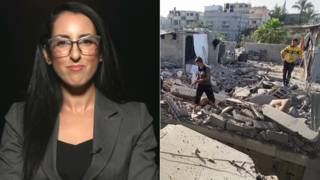
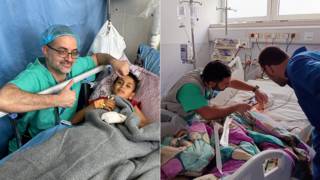
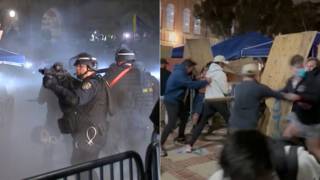
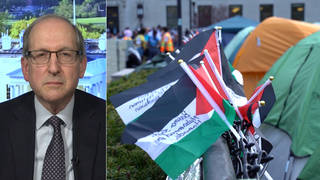
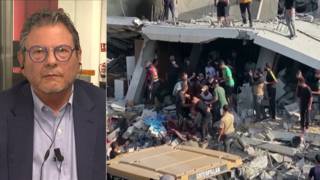




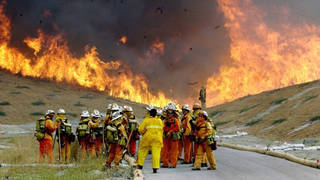

Media Options